We spent two days in Kraków.
- Stained Glass Museum:
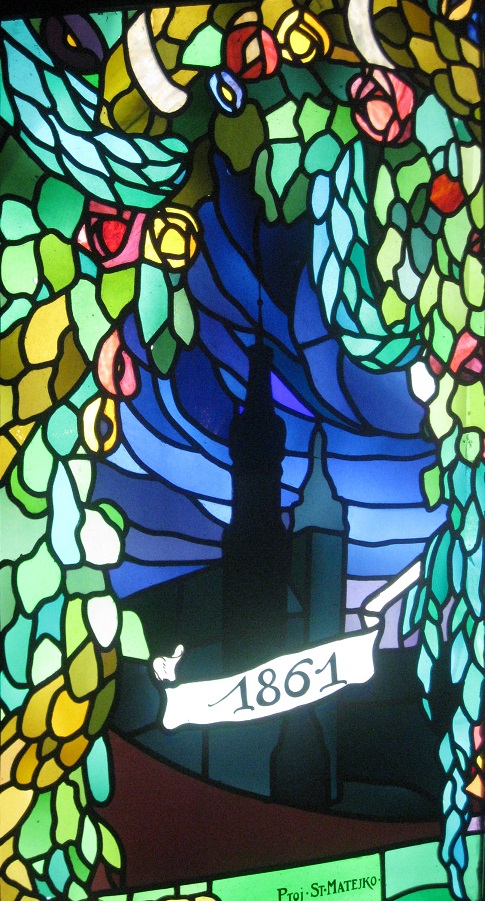 The name is a bit misleading: this is actually a tour of a workshop where stained glass windows are produced. It’s a great look at the process of making them: from colored glass characteristics and cutting with diamond tools to lead joiners between glass pieces and paint layered atop glass. It was really interesting to see them in action and to meet the Glass Master who had made works we saw around the city. I’m glad we scheduled our day around it – and not just because they had glass works with non-religious motifs.
The name is a bit misleading: this is actually a tour of a workshop where stained glass windows are produced. It’s a great look at the process of making them: from colored glass characteristics and cutting with diamond tools to lead joiners between glass pieces and paint layered atop glass. It was really interesting to see them in action and to meet the Glass Master who had made works we saw around the city. I’m glad we scheduled our day around it – and not just because they had glass works with non-religious motifs. - Kazimierz (Jewish Quarter): We took a walking tour of this neighborhood, the Jewish center of the area (after Jews were kicked out of Kraków proper, of course). There were >60K Jewish people living there before the war, and today – even counting what our guide called ‘secular’ Jews, there are only 730. The tour told the story of how they lived, and how they were marched across the river to create a ghetto, where many were later shot or shipped to extermination camps. There were positive stories of Poles throwing food to the starving Jews as their trams passed through the ghetto, and negative ones of how the top of the ghetto walls were purposely built to resemble the top of Jewish tombstones. One of my favorite stories was the reminder that though the Nazis hated the Jews, they also feared them, as if they were witches or mystics. So, while they happily desecrated synagogues, cemeteries, and homes, not one of them touched the headstone of a widely-followed rabbi from the 1500s, for fear of being hexed – or some such.
- Plac Nowy Flea Market:
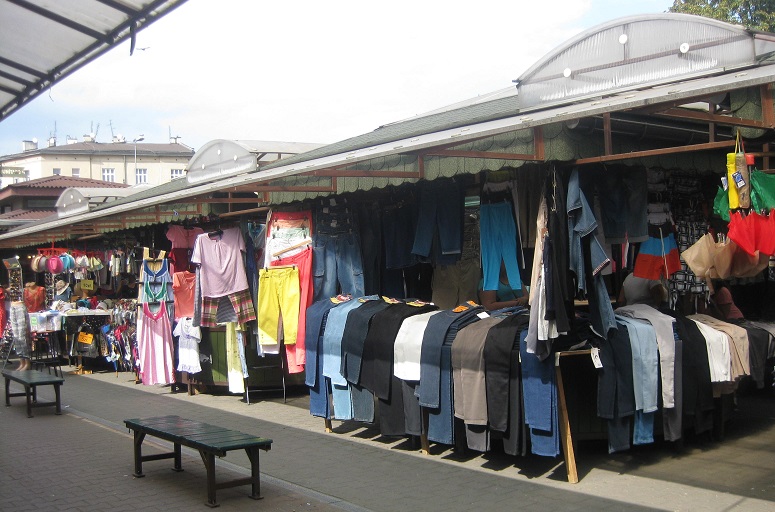 Another city, another market selling farm-grown vegetables next to DDD bras.
Another city, another market selling farm-grown vegetables next to DDD bras. - Galicia Museum: I may as well cover all of the depressing bits at once (minus the incident with the arrow, below). This is a museum of Jewish history in Poland, told through modern-day photos. It’s mostly an exhibit of photographs showing fields and ruins, since that’s pretty much all that remains of the life of the millions of Jews who once populated Poland. Translation: if you’re squeamish, but understand that a visit to Poland is incomplete without seeing it as the site of one of the worst genocides in history, this museum is for you. The curation was pretty good, overall, and there was an extra exhibit of a former-dressmaker’s tapestries showing her experience surviving the Holocaust; made all the more moving because the designs are so colorful, you almost feel like they could be samplers or quilts in your home. And then you see in the tapestry, the Nazis trying to beat her father to death for quietly saying a prayer in his home on Passover.
- Main Market Square: This is a fun square, with cafes lining the outside. We sat in one and people-watched as a horse carriage driver almost clipped a table,
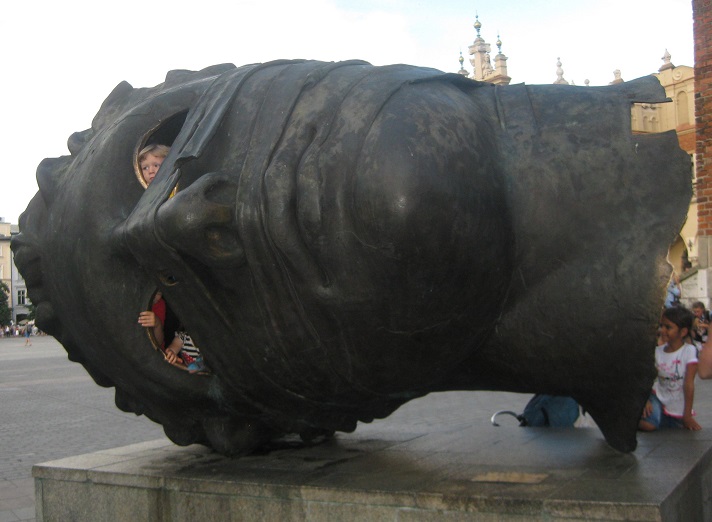
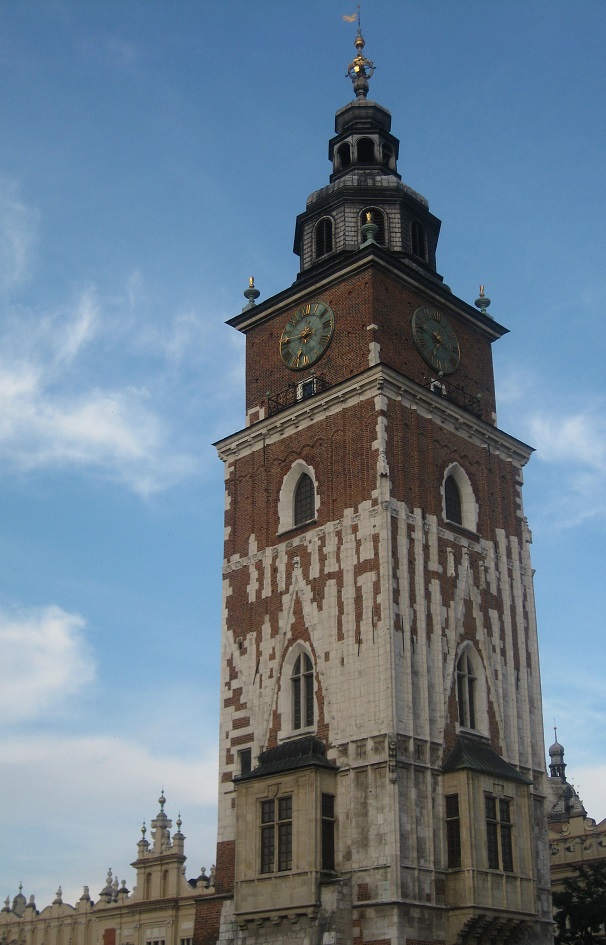 as kids climbed inside a sculpture of a head on its side, and as people traipsed over the cobblestones in high heels. In the middle of the square is a market with souvenir stands, selling all manner of tourist kibble, from amber jewelry to caricatures of rabbis and Polish peasants. There’s also a cool tower in the square, flanked by some weird sculptures. And in the corner is St. Mary’s Basilica, out of which a trumpeter does a 5-note call every hour. Legend claims that it began with a trumpeter in the 1300s who sounded the alarm that the Tatars were invading – allowing the city to close its gates in time to avoid capture. Sadly for him, the Tatars managed to shoot him in the throat for his perfidy, stopping his song early: hence, the reason for only a 5-note song.
as kids climbed inside a sculpture of a head on its side, and as people traipsed over the cobblestones in high heels. In the middle of the square is a market with souvenir stands, selling all manner of tourist kibble, from amber jewelry to caricatures of rabbis and Polish peasants. There’s also a cool tower in the square, flanked by some weird sculptures. And in the corner is St. Mary’s Basilica, out of which a trumpeter does a 5-note call every hour. Legend claims that it began with a trumpeter in the 1300s who sounded the alarm that the Tatars were invading – allowing the city to close its gates in time to avoid capture. Sadly for him, the Tatars managed to shoot him in the throat for his perfidy, stopping his song early: hence, the reason for only a 5-note song. - Small Market Square: The square itself is nothing special (except for one small water bath),
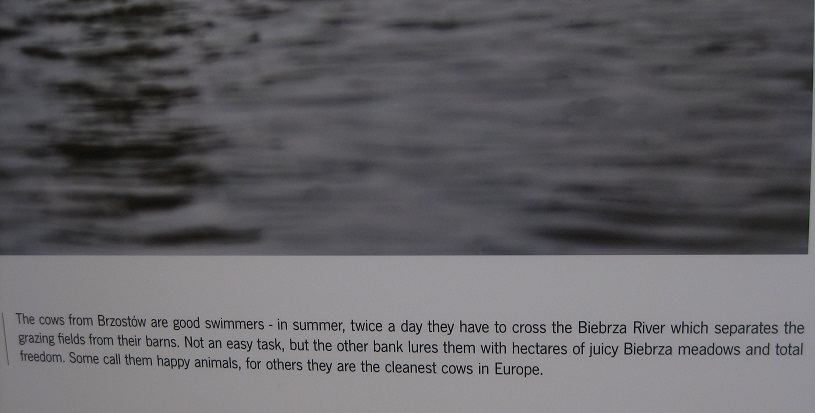 but it held two photography exhibits that were really interesting. One was photographs by a Pole from the region in which Kraków finds itself. He lived his whole life there and never took a photograph anywhere else, as he didn’t think anywhere else had beauty; the exhibit referred to it as true loyalty. The photos themselves were beautiful images of the countryside and its cattle – in mists, sunsets, water reflections, and more. The second exhibit showed the region’s people doing everyday things, from swimming in bogs to making farm equipment. Not sure how often they rotate the exhibits, but this was a happy discovery.
but it held two photography exhibits that were really interesting. One was photographs by a Pole from the region in which Kraków finds itself. He lived his whole life there and never took a photograph anywhere else, as he didn’t think anywhere else had beauty; the exhibit referred to it as true loyalty. The photos themselves were beautiful images of the countryside and its cattle – in mists, sunsets, water reflections, and more. The second exhibit showed the region’s people doing everyday things, from swimming in bogs to making farm equipment. Not sure how often they rotate the exhibits, but this was a happy discovery. - Wawel Hill, Castle, and Dragon:
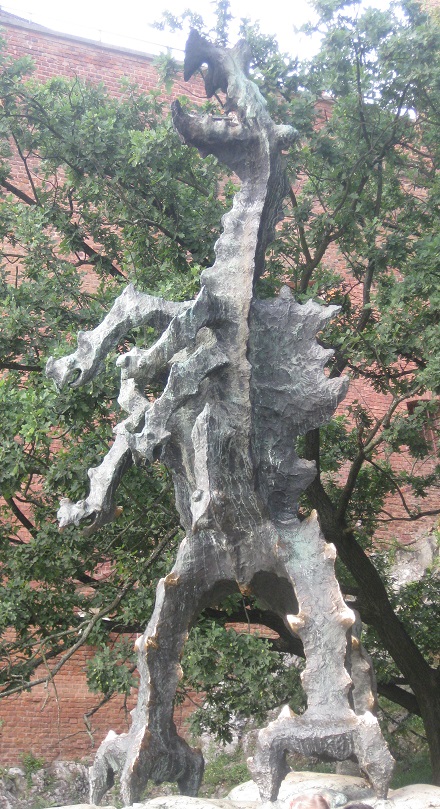 It was a nice castle exterior, but we were too tired to trek to the top. Instead, we watched this dragon statue ‘breathe fire’ and took photos of the outside. They say they have good, special candy inside, but that shows the exact nature of our exhaustion, since even chocolate didn’t compel me inside. (Of course, dessert was not forgone: just relocated to a nearby cafe, which wasn’t up a hill.)
It was a nice castle exterior, but we were too tired to trek to the top. Instead, we watched this dragon statue ‘breathe fire’ and took photos of the outside. They say they have good, special candy inside, but that shows the exact nature of our exhaustion, since even chocolate didn’t compel me inside. (Of course, dessert was not forgone: just relocated to a nearby cafe, which wasn’t up a hill.) - Milk Bars: ‘Milk bars’ have become the tourist attraction ‘du jour’ in Poland. This is a trend I can get behind because gawking at low prices and eating homemade food is my kind of sightseeing. ‘Milk bars’ have nothing to do with milk or with bars: they’re Soviet-era cafeterias with cheap, homemade food. Imagine a black and white menu listing everything from soups to entrees to ketchup (all in Polish, mind you), with prices and sizes on the side. You get in line, rattle off your order, pay them the ridiculously-low amount, and sit at a cheap plastic tablecloth table, scarfing your meal in quiet. Alternatively, you bring giant tupperware containers from your house and get the food to go – presumably because homemade food is better than anything else you can get when you have no time to cook. This is the sort of place where eating alone is normal, and where people will just join your little table if all the seats fill up. The clientele ranges from families to very elderly people, and the food is the Polish basics: soups, cabbage things, pierogies (dumplings), naleśniki (crepes), kotlet (schnitzel/ breaded meat), etc. When you’re done, you bus your dishes to a window, freeing up your table for others.
What We Skipped:
- Schindler Factory Museum: The only portion of this factory which remains is its gate, so the name is a bit of a misnomer. We didn’t go because we feared it would be too centered on the movie, which I’ve never been able to bring myself to watch. We were also hungry and sunburnt. Also, the outside of the museum shows the photographs and names of the Jews saved by Schindler. In glancing at the several hundred names, I noticed first names shared by my great-grandmother, my great-grandfather, my grandmother, my mother, and myself. In case it wasn’t real enough that it could have been me. (Cheery, I know.)
- Museum of Contemporary Art: They had photos of the main exhibit, which looked like kids playground equipment. I am opposed to paying to stand next to bright red poles I cannot climb, as uneducated as that sounds.
- Nowa Huta: The ‘communist’ suburbs of the city, this area apparently has old Soviet tanks and planes in the streets. I actually saw one of the planes on the way to the airport, though I initially thought it was just a large toy in someone’s garden. There are tours of the area, and the opportunity to shoot a Kalishnikov (AK47) gun, for only $80 each. We passed.
- Rynek Underground Museum: B said this sounded like a hokey reconstruction of 12th century Poland, with bad costumes and worse acting. He said that their description of the museum as ‘time machine’ tipped him off.
- Galleries of 19th and 20th Century Polish Art: We were museum-ed out.
- The Archaeology Museum: Ditto.
- Czartoryski Museum: Closed for renovation.
- Vistula River Boat Ride: It didn’t look particularly cool (or long), so we just sat on the banks of the river and enjoyed it that way.
- Wieliczka Salt Mine: B read reviews that said this had become a sales-tactic tour in which the mine viewing was rushed, so visitors could spend hours in mine gift shops. (‘How many can they possible have?,’ I asked. Many, turns out.) Add in reviewers’ claims that only one portion was worth seeing, and that online photos did it justice, along with the fervor of the haters, and we decided to pass.
- Auschwitz: This is a tough one, which we debated in depth. I’ve been to a camp like this, and we’ve been to multiple Holocaust-related monuments, museums, and commemorations here in Poland. Ultimately, I think the experience at a place like this is not the same as any other thing you can do, but for personal reasons I’ll detail elsewhere, we decided not to go to this one.



Pingback: What We Ate in Kraków – Novelty Buffs